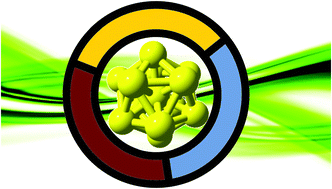On the ligand–core interaction in ligand-protected gold superatoms. Insights from Au25(XR)18 (X = S, Se, Te) via relativistic DFT calculations†
Abstract
The stabilization of gold nanoparticles by using thiolate-based ligands is a relevant issue in the design of functional nanostructures. Superatomic clusters, through the prominent Au25(SR)18 aggregate, offer a prototypical template to deepen the understanding of the different behaviors gained by the inclusion of different chalcogen atoms at the ligand layer. Through the study of [Au25(XMe)18]− (X = S, Se and Te), our results revealed that the bonding between the formally [Au13]5+ core and the protecting layer (PL), further involves the unoccupied 1D-, 1F- and 2S-[Au13] superatomic shells, acting as a charge acceptor in the PL → Au13 charge transfer upon formation of the cluster. In addition, the optical properties showed an increase in the Stokes shift between the S0 → S1 excitation, and S0 ← S1 emission, going from –SMe to –TeMe, owing to a more distorted core in the excited state for the heavier counterpart. The approach here employed expands the bonding picture between the [Au13]5+ and the protecting layer between different anchor atoms, in addition to the formal ionic description of an isolated core. These findings seek to enhance our understanding of bonding, and the optical characteristic resulting from the use of heavier chalcogen atoms in the protecting layer, which can be employed as design guidelines to incorporate or modify the molecular properties towards the synthesis of ligand-protected gold clusters.



 Please wait while we load your content...
Please wait while we load your content...